Rameswar Panda
Richard
Stick-breaking Attention
Oct 23, 2024



Abstract:The self-attention mechanism traditionally relies on the softmax operator, necessitating positional embeddings like RoPE, or position biases to account for token order. But current methods using still face length generalisation challenges. We propose an alternative attention mechanism based on the stick-breaking process: For each token before the current, we determine a break point $\beta_{i,j}$, which represents the proportion of the remaining stick to allocate to the current token. We repeat the process until the stick is fully allocated, resulting in a sequence of attention weights. This process naturally incorporates recency bias, which has linguistic motivations for grammar parsing (Shen et. al., 2017). We study the implications of replacing the conventional softmax-based attention mechanism with stick-breaking attention. We then discuss implementation of numerically stable stick-breaking attention and adapt Flash Attention to accommodate this mechanism. When used as a drop-in replacement for current softmax+RoPE attention systems, we find that stick-breaking attention performs competitively with current methods on length generalisation and downstream tasks. Stick-breaking also performs well at length generalisation, allowing a model trained with $2^{11}$ context window to perform well at $2^{14}$ with perplexity improvements.
Calibrating Expressions of Certainty
Oct 06, 2024Abstract:We present a novel approach to calibrating linguistic expressions of certainty, e.g., "Maybe" and "Likely". Unlike prior work that assigns a single score to each certainty phrase, we model uncertainty as distributions over the simplex to capture their semantics more accurately. To accommodate this new representation of certainty, we generalize existing measures of miscalibration and introduce a novel post-hoc calibration method. Leveraging these tools, we analyze the calibration of both humans (e.g., radiologists) and computational models (e.g., language models) and provide interpretable suggestions to improve their calibration.
SITAR: Semi-supervised Image Transformer for Action Recognition
Sep 04, 2024

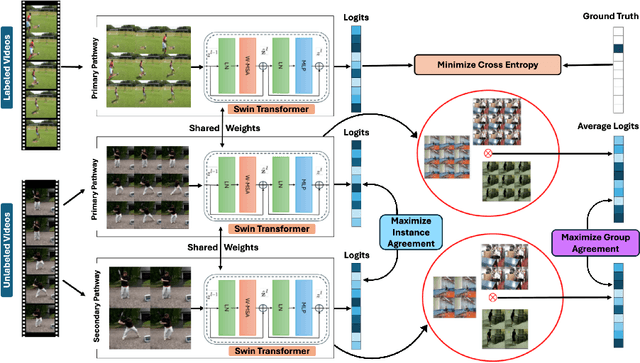

Abstract:Recognizing actions from a limited set of labeled videos remains a challenge as annotating visual data is not only tedious but also can be expensive due to classified nature. Moreover, handling spatio-temporal data using deep $3$D transformers for this can introduce significant computational complexity. In this paper, our objective is to address video action recognition in a semi-supervised setting by leveraging only a handful of labeled videos along with a collection of unlabeled videos in a compute efficient manner. Specifically, we rearrange multiple frames from the input videos in row-column form to construct super images. Subsequently, we capitalize on the vast pool of unlabeled samples and employ contrastive learning on the encoded super images. Our proposed approach employs two pathways to generate representations for temporally augmented super images originating from the same video. Specifically, we utilize a 2D image-transformer to generate representations and apply a contrastive loss function to minimize the similarity between representations from different videos while maximizing the representations of identical videos. Our method demonstrates superior performance compared to existing state-of-the-art approaches for semi-supervised action recognition across various benchmark datasets, all while significantly reducing computational costs.
Power Scheduler: A Batch Size and Token Number Agnostic Learning Rate Scheduler
Aug 23, 2024Abstract:Finding the optimal learning rate for language model pretraining is a challenging task. This is not only because there is a complicated correlation between learning rate, batch size, number of training tokens, model size, and other hyperparameters but also because it is prohibitively expensive to perform a hyperparameter search for large language models with Billions or Trillions of parameters. Recent studies propose using small proxy models and small corpus to perform hyperparameter searches and transposing the optimal parameters to large models and large corpus. While the zero-shot transferability is theoretically and empirically proven for model size related hyperparameters, like depth and width, the zero-shot transfer from small corpus to large corpus is underexplored. In this paper, we study the correlation between optimal learning rate, batch size, and number of training tokens for the recently proposed WSD scheduler. After thousands of small experiments, we found a power-law relationship between variables and demonstrated its transferability across model sizes. Based on the observation, we propose a new learning rate scheduler, Power scheduler, that is agnostic about the number of training tokens and batch size. The experiment shows that combining the Power scheduler with Maximum Update Parameterization (muP) can consistently achieve impressive performance with one set of hyperparameters regardless of the number of training tokens, batch size, model size, and even model architecture. Our 3B dense and MoE models trained with the Power scheduler achieve comparable performance as state-of-the-art small language models. We open-source these pretrained models at https://ibm.biz/BdKhLa.
Scaling Granite Code Models to 128K Context
Jul 18, 2024Abstract:This paper introduces long-context Granite code models that support effective context windows of up to 128K tokens. Our solution for scaling context length of Granite 3B/8B code models from 2K/4K to 128K consists of a light-weight continual pretraining by gradually increasing its RoPE base frequency with repository-level file packing and length-upsampled long-context data. Additionally, we also release instruction-tuned models with long-context support which are derived by further finetuning the long context base models on a mix of permissively licensed short and long-context instruction-response pairs. While comparing to the original short-context Granite code models, our long-context models achieve significant improvements on long-context tasks without any noticeable performance degradation on regular code completion benchmarks (e.g., HumanEval). We release all our long-context Granite code models under an Apache 2.0 license for both research and commercial use.
The infrastructure powering IBM's Gen AI model development
Jul 07, 2024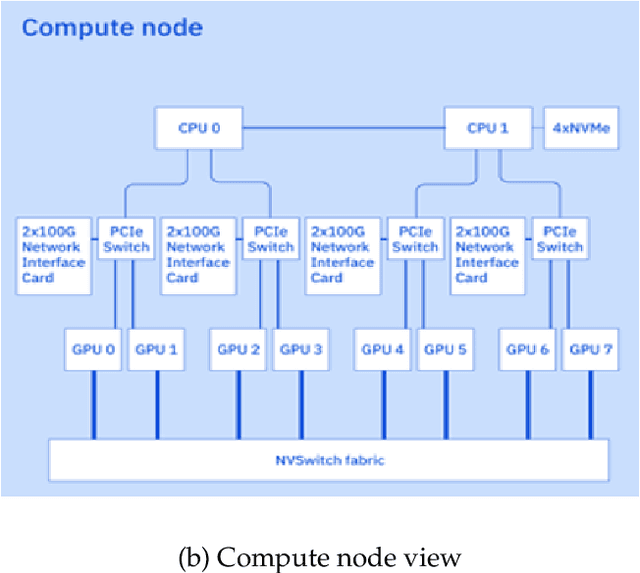
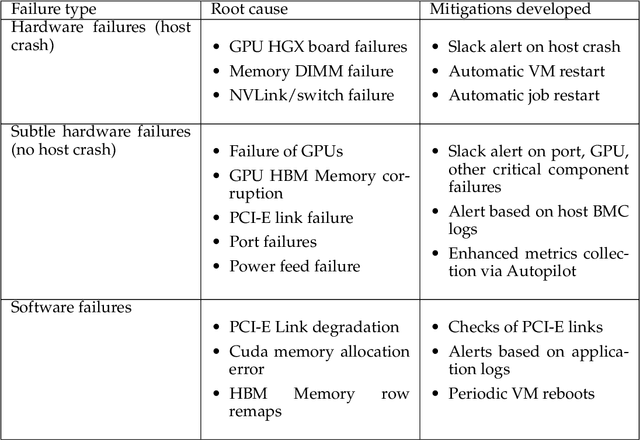
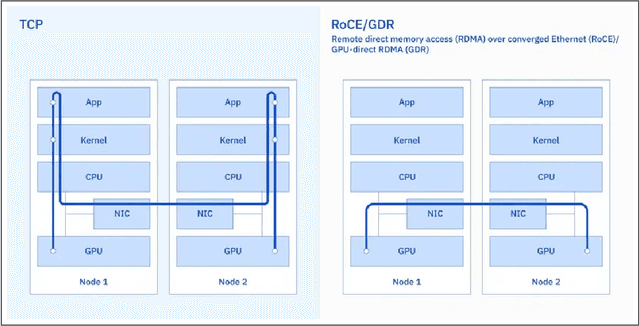

Abstract:AI Infrastructure plays a key role in the speed and cost-competitiveness of developing and deploying advanced AI models. The current demand for powerful AI infrastructure for model training is driven by the emergence of generative AI and foundational models, where on occasion thousands of GPUs must cooperate on a single training job for the model to be trained in a reasonable time. Delivering efficient and high-performing AI training requires an end-to-end solution that combines hardware, software and holistic telemetry to cater for multiple types of AI workloads. In this report, we describe IBM's hybrid cloud infrastructure that powers our generative AI model development. This infrastructure includes (1) Vela: an AI-optimized supercomputing capability directly integrated into the IBM Cloud, delivering scalable, dynamic, multi-tenant and geographically distributed infrastructure for large-scale model training and other AI workflow steps and (2) Blue Vela: a large-scale, purpose-built, on-premises hosting environment that is optimized to support our largest and most ambitious AI model training tasks. Vela provides IBM with the dual benefit of high performance for internal use along with the flexibility to adapt to an evolving commercial landscape. Blue Vela provides us with the benefits of rapid development of our largest and most ambitious models, as well as future-proofing against the evolving model landscape in the industry. Taken together, they provide IBM with the ability to rapidly innovate in the development of both AI models and commercial offerings.
Granite-Function Calling Model: Introducing Function Calling Abilities via Multi-task Learning of Granular Tasks
Jun 27, 2024


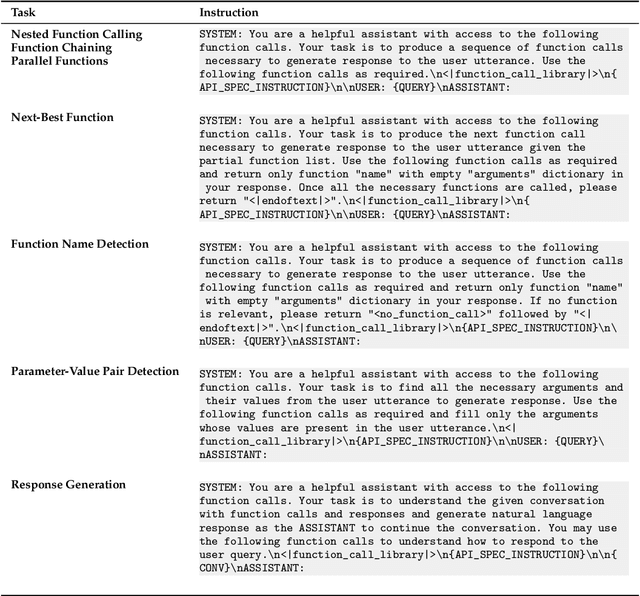
Abstract:Large language models (LLMs) have recently shown tremendous promise in serving as the backbone to agentic systems, as demonstrated by their performance in multi-faceted, challenging benchmarks like SWE-Bench and Agent-Bench. However, to realize the true potential of LLMs as autonomous agents, they must learn to identify, call, and interact with external tools and application program interfaces (APIs) to complete complex tasks. These tasks together are termed function calling. Endowing LLMs with function calling abilities leads to a myriad of advantages, such as access to current and domain-specific information in databases and knowledge sources, and the ability to outsource tasks that can be reliably performed by tools, e.g., a Python interpreter or calculator. While there has been significant progress in function calling with LLMs, there is still a dearth of open models that perform on par with proprietary LLMs like GPT, Claude, and Gemini. Therefore, in this work, we introduce the GRANITE-20B-FUNCTIONCALLING model under an Apache 2.0 license. The model is trained using a multi-task training approach on seven fundamental tasks encompassed in function calling, those being Nested Function Calling, Function Chaining, Parallel Functions, Function Name Detection, Parameter-Value Pair Detection, Next-Best Function, and Response Generation. We present a comprehensive evaluation on multiple out-of-domain datasets comparing GRANITE-20B-FUNCTIONCALLING to more than 15 other best proprietary and open models. GRANITE-20B-FUNCTIONCALLING provides the best performance among all open models on the Berkeley Function Calling Leaderboard and fourth overall. As a result of the diverse tasks and datasets used for training our model, we show that GRANITE-20B-FUNCTIONCALLING has better generalizability on multiple tasks in seven different evaluation datasets.
Self-MoE: Towards Compositional Large Language Models with Self-Specialized Experts
Jun 17, 2024Abstract:We present Self-MoE, an approach that transforms a monolithic LLM into a compositional, modular system of self-specialized experts, named MiXSE (MiXture of Self-specialized Experts). Our approach leverages self-specialization, which constructs expert modules using self-generated synthetic data, each equipped with a shared base LLM and incorporating self-optimized routing. This allows for dynamic and capability-specific handling of various target tasks, enhancing overall capabilities, without extensive human-labeled data and added parameters. Our empirical results reveal that specializing LLMs may exhibit potential trade-offs in performances on non-specialized tasks. On the other hand, our Self-MoE demonstrates substantial improvements over the base LLM across diverse benchmarks such as knowledge, reasoning, math, and coding. It also consistently outperforms other methods, including instance merging and weight merging, while offering better flexibility and interpretability by design with semantic experts and routing. Our findings highlight the critical role of modularity and the potential of self-improvement in achieving efficient, scalable, and adaptable systems.
Reducing Transformer Key-Value Cache Size with Cross-Layer Attention
May 21, 2024Abstract:Key-value (KV) caching plays an essential role in accelerating decoding for transformer-based autoregressive large language models (LLMs). However, the amount of memory required to store the KV cache can become prohibitive at long sequence lengths and large batch sizes. Since the invention of the transformer, two of the most effective interventions discovered for reducing the size of the KV cache have been Multi-Query Attention (MQA) and its generalization, Grouped-Query Attention (GQA). MQA and GQA both modify the design of the attention block so that multiple query heads can share a single key/value head, reducing the number of distinct key/value heads by a large factor while only minimally degrading accuracy. In this paper, we show that it is possible to take Multi-Query Attention a step further by also sharing key and value heads between adjacent layers, yielding a new attention design we call Cross-Layer Attention (CLA). With CLA, we find that it is possible to reduce the size of the KV cache by another 2x while maintaining nearly the same accuracy as unmodified MQA. In experiments training 1B- and 3B-parameter models from scratch, we demonstrate that CLA provides a Pareto improvement over the memory/accuracy tradeoffs which are possible with traditional MQA, enabling inference with longer sequence lengths and larger batch sizes than would otherwise be possible
Granite Code Models: A Family of Open Foundation Models for Code Intelligence
May 07, 2024



Abstract:Large Language Models (LLMs) trained on code are revolutionizing the software development process. Increasingly, code LLMs are being integrated into software development environments to improve the productivity of human programmers, and LLM-based agents are beginning to show promise for handling complex tasks autonomously. Realizing the full potential of code LLMs requires a wide range of capabilities, including code generation, fixing bugs, explaining and documenting code, maintaining repositories, and more. In this work, we introduce the Granite series of decoder-only code models for code generative tasks, trained with code written in 116 programming languages. The Granite Code models family consists of models ranging in size from 3 to 34 billion parameters, suitable for applications ranging from complex application modernization tasks to on-device memory-constrained use cases. Evaluation on a comprehensive set of tasks demonstrates that Granite Code models consistently reaches state-of-the-art performance among available open-source code LLMs. The Granite Code model family was optimized for enterprise software development workflows and performs well across a range of coding tasks (e.g. code generation, fixing and explanation), making it a versatile all around code model. We release all our Granite Code models under an Apache 2.0 license for both research and commercial use.
 Add to Chrome
Add to Chrome Add to Firefox
Add to Firefox Add to Edge
Add to Edge